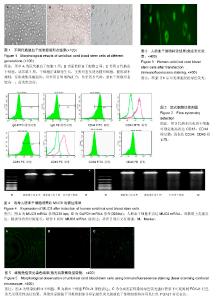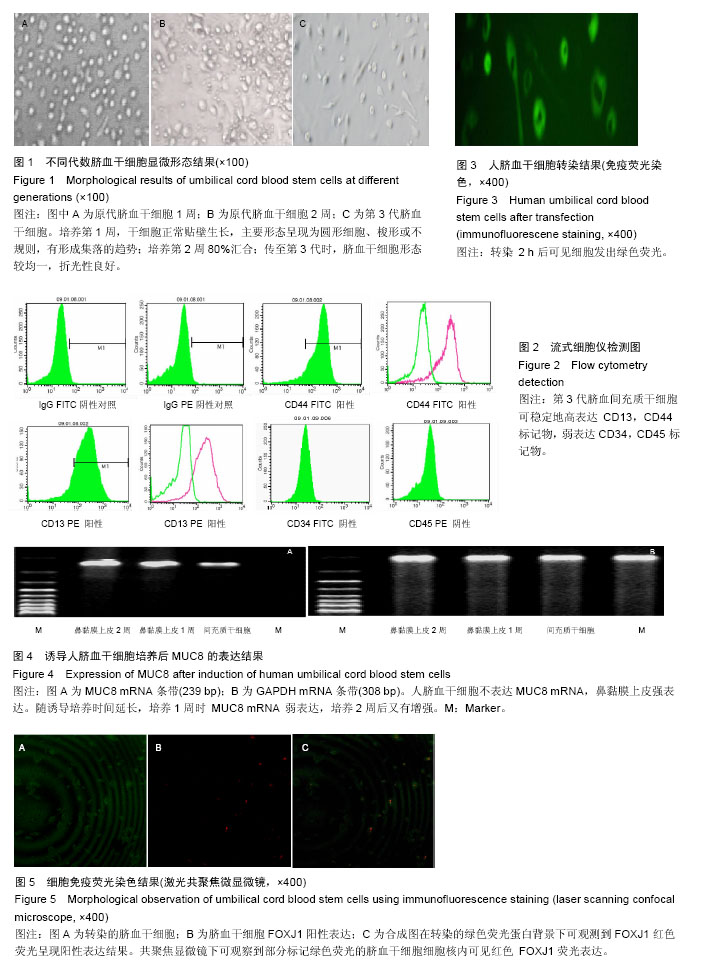Chinese Journal of Tissue Engineering Research ›› 2016, Vol. 20 ›› Issue (32): 4764-4770.doi: 10.3969/j.issn.2095-4344.2016.32.008
Previous Articles Next Articles
Human umbilical cord blood stem cells differentiate into nasal ciliated epithelial cells
Dong Jin-hui, Ren Xiu-min, Xu Ou, Wang Jian-xing
- Department of Otolaryngology, Second Hospital of Hebei Medical University, Shijiazhuang 050000, Hebei Province, China
-
Revised:2016-06-01Online:2016-08-05Published:2016-08-05 -
Contact:Dong Jin-hui, Department of Otolaryngology, Second Hospital of Hebei Medical University, Shijiazhuang 050000, Hebei Province, China -
About author:Dong Jin-hui, Master, Attending physician, Department of Otolaryngology, Second Hospital of Hebei Medical University, Shijiazhuang 050000, Hebei Province, China -
Supported by:the Medical Research Project of Hebei Province of China in 2014, No. ZL20140002
CLC Number:
Cite this article
Dong Jin-hui, Ren Xiu-min, Xu Ou, Wang Jian-xing. Human umbilical cord blood stem cells differentiate into nasal ciliated epithelial cells[J]. Chinese Journal of Tissue Engineering Research, 2016, 20(32): 4764-4770.
share this article

2.1 人脐血干细胞显微形态 原代人脐血干细胞接种后,于37 ℃,体积分数5%CO2饱和湿度培养箱培养1周后,干细胞正常贴壁生长,出现多种形态,主要形态呈现为圆形细胞、梭形或不规则,有形成集落的趋势。换取培养基后继续于培养箱中培养至第4周时,脐血干细胞融合达80%以上,可正常传代。干细胞传至第3代时,光学显微镜下观察,可见脐血干细胞形态较均一,折光性良好,见图1。 2.2 人脐血干细胞表面抗原标记物表达特征 经流式细胞仪检测结果显示,P3代脐血间充质干细胞稳定地高表达CD13和CD44等表面抗原标记物,阳性率分别为86.18%和90.30%,弱表达CD34和CD45等造血细胞标志,表明间充质干细胞是存在于脐血中区别于造血细胞的一群非定向干/祖细胞,这与骨髓间充质干细胞的表面抗原标志相一致,见图2。 2.3 人脐血干细胞的转染及转染率结果 第3代人脐血干细胞被重组腺相关病毒转染3 h后,于荧光倒置显微镜下观察,可见第3代干细胞呈现出绿色荧光(图3),而对照组细胞未见绿色荧光。干细胞培养48 h后,经流式细胞仪检测,细胞阳性率达96.2%,说明干细胞转染效果较好。 2.4 MUC8基因的表达 RT-PCR结果显示:人脐血干细胞MUC8 mRNA无表达;鼻黏膜上皮细胞MUC8 mRNA呈现出强表达,而且随重组腺相关病毒诱导培养时间的延长,培养1周时MUC8 mRNA呈现弱表达,培养2周后有一定的增强。内参照基因为GAPDH,阳性条带为308 bp,见图4。 2.5 细胞免疫荧光染色检测结果 人脐血干细胞培养3周后进行免疫荧光染色,显微镜下未检测到β-Tubulin表达,而在转染的绿色荧光蛋白背景下可观测到FOXJ1红色荧光呈现阳性表达结果。共聚焦显微镜下可观察到部分标记绿色荧光的脐血干细胞细胞核内可见红色 FOXJ1荧光表达,见图5。"

| [1] 中华耳鼻咽喉头颈外科杂志编委会,中华医学会耳鼻咽喉头颈外科学分会鼻科学组.慢性鼻-鼻窦炎诊断和诊疗指南(2012年,昆明) [J].中华耳鼻咽喉头颈外科杂志, 2013,48(2):92-94. [2] Claire H, Robert S, Valerie L, et al. Long-term outcomes from the English national comparative audit of surgery for nasal polyposis and chronic rhinosinusitis. Laryngoscope. 2009;119(12):2459-2465.
[3] Fan YP, Feng SY. Aspirin-exacerbated respiratory disease in China: a cohort investigation and literature review. Am J Rhinol Allergy 26:20-22.
[4] Dutta R, Dubal PM, Eloy JA. The connection between seasonal allergies, food allergies, and rhinosinusitis: what is the evidence? Curr Opin Otolaryngol Head Neck Surg. 2015;23(23):2-7.
[5] Martin EJ, Forkert PG. 1, 1-Dichloroethylene-induced mitochondrial damage precedes apoptotic cell death of bronchiolar epithelial cells in murine lung. J Pharmacol Exp Ther. 2005;313(1):95-103.
[6] 郭永清,赵小冬,杨占泉.气液界面培养的鼻黏膜上皮细胞的纤毛分化[J].临床耳鼻咽喉头颈外科杂志,2004,18(2): 88-90.
[7] 江英,席克虎,陈小婉,等.18β-甘草次酸对变应性鼻炎大鼠鼻黏膜纤毛超微结构的影响[J].第二军医大学学报, 2015, 36(1):26-33.
[8] 夏忠芳,孔维佳,乐建新,等.人正常鼻黏膜及鼻息肉黏膜上皮细胞的原代培养及鉴定[J].华中科技大学学报:医学版, 2008,37(4):541-543.
[9] 裴雪涛.干细胞生物学[M].北京:科学出版社,2003.
[10] Perrin L, Giuliani S, Sedrakyan S, et al. Stem cell and regenerative science application in the development of bioengineering of renal tissue. Pediatr Res. 2008;63(5): 467-471.
[11] Yamamoto Y, Banas A, Murata S, et al. A comparative analysis of the transcriptome and signal pathways in hepatic differentiation of human adipose mesenchymal stem cell. FEBS J. 2008;275(6):1260-1273.
[12] Urbán VS, Kiss J, Kovács J, et al. Mesenchymal stem cells cooperate with bone marrow cells in therapy of diabetes. Stem Cells. 2008;26(1):244-253.
[13] Cho KJ, Trzaska KA, Greco SJ, et al. Neurons derived from human mesenchymal stem cells show synaptic transmission and can be induced to produce the neuro-transmitter substance P by interleukin-1 alpha. Stem Cells. 2005;23(3):383-391.
[14] 裴雪涛.干细胞实验指南[M].北京:科学出版社,2006.
[15] Hanna J, Wernig M, Markoulaki S, et al. Treatment of sickle cell anemia mouse model with ips cells generated from autologous skin. Science. 2007;318: 1920-1923.
[16] Hirata Y, Sata M, Motomura N, et al. Human umbilical cord blood cells improve cardiac function after myocardial infarction. Biochem Biophys Res Commun. 2005;327:609-614.
[17] Rippon HJ, Lane S, Qin M, et al. Embryonic stem cells as a source of pulmonary epithelium in vitro and in vivo. Proc Am Thorac Soc. 2008;5:717-722.
[18] Chan KM, Raikwar SP, Zavazava N. Strategies for differentiating embryonic stem cells (ESC) into insulin-producing cells and development of non-invasive imaging techniques using bioluminescence. Immunol Res. 2007;39(1-3): 261- 270.
[19] Weiss DJ, Berberich MA, Borok Z, et al. Adult stem cells, lung biology, and lung disease. NHLBI/-Cystic Fibrosis Foundation Workshop. Proc Am Thorac Soc. 2006;3:193-207.
[20] Wang GS, Bunnell BA, Richard G. Painter et al. Adult stem cells from bone marrow stroma differentiate into airway epithelial cells: potential therapy for cystic fibrosis. PNAS. 2005;102(1):186-191.
[21] 张丽欣,邢利和,张丽丽,等.脐血干细胞移植治疗失代偿期肝硬化的临床效果研究[J].中国全科医学,2010,13(24): 2680-2682.
[22] 肖日军.脐血干细胞移植治疗糖尿病大鼠下肢缺血的实验研究[J].中华损伤与修复杂志:电子版,2012,7(1): 12-16.
[23] Kogler G, Sensken S, Airey JA, et al. A new human somatic stem cell from placental cord blood with intrincis pluripotent differentiation potential. J Exp Med. 2004;200:123-135.
[24] Sueblinvong V, Loi R, Philip L, et al. Derivation of lung epithelium from human cord blood-derived mesenchymal stem cells. Am J Respir Crit Care Med. 2008;177(3):701-711.
[25] 杜冀晖,张鲍虎,李蓉,等.人脐血干细胞蛛网膜下腔移植向神经干细胞分化的初步研究[J].国际检验医学杂志,2008, 29(8):676-678.
[26] 赵长青,安云芳,索利敏.脐血间充质干细胞体外分化鼻黏膜纤毛上皮细胞的研究[C].全国鼻部感染与变态反应专题学术会议,2011,(4):12-16.
[27] 张少丹,李武平.呼吸道上皮细胞模型的研究进展[J].病毒学报,2015,31(3):307-312.
[28] García-Gareta E. Collagen gels and the ‘Bornstein legacy’: from a substrate for tissue culture to cell culture systems and biomaterials for tissue regeneration. Exp Dermatol. 2014;23(7):473-474.
[29] Chaaban MR, Alexandra K, Rowe SM, et al. Cystic fibrosis chronic rhinosinusitis: a comprehensive review. Am J Rhinol Allergy. 2013;27(5):387-395.
[30] 籍凤宇,李佳佳,陈秀莉,等.脐血干细胞向不同体细胞分化的研究进展[J].生物技术通报,2012,28(1):30-36.
[31] Dursun E, Korkmaz H, Eryilmaz A, et al. Clinical pridictors of long-term success after endoscopic sinus surgery. Otolaryngol Head Neck Srug. 2003;129: 526-531.
[32] Jing Y, Jian-xiong Y. 3-D spheroid culture of bone marrow mesenchymal stem cell of rhesus monkey with improved multi-differentiation potential to epithelial progenitors and neuron in vitro. Clin Exp Ophthalmol. 2011;39(8):808-819.
[33] Askvig JM, Lo DY, Sudbeck AW, et al. Inhibition of the Jak-STAT pathway prevents CNTF-mediated survival of axotomized oxytocinergic magnocellular neurons in organotypic cultures of the rat supraoptic nucleus. Exp Neurol. 2013;240(1):75-87.
[34] Hirata Y, Sata M, Motomura N, et al. Human umbilical cord blood cells improve cardiac function after myocardial infarction. Biochem Biophys Res Commun. 2005;327:609-614.
[35] Sharma AD, Cantz T, Richter R, et al. Human cord blood stem cells generate human cytokeratin 18-negative hepatocyte-like cells in injured mouse liver. Am J Pathol. 2005;167:555-564.
[36] Sueblinvong V, Loi R, Eisenhauer PL, et al. Derivation of lung epithelium from human cord blood–derived mesenchymal stem cells. Am J Respir Crit Care Med. 2008;177:701-711.
[37] 孙浩平.人脐血源间充质干细胞与其基质细胞对体外造血调控作用的比较研究[D].重庆:第三军医大学,2012.
[38] Musina RA, Bekchanova ES, Belyavskii AV, et al. Umbilical cord blood mesenchymal stem cells. Bull Exp Biol Med. 2007;143(1):127-131.
[39] Murrella W, Wetziga A, Donnellana M, et al. Olfactory mucosa is a potential source for autologous stem cell therapy for parkinson's disease. Stem Cells. 2008; 26(8): 2183-2192.
[40] 兰扎[美].干细胞手册(全2卷)(精)[M].北京:科学出版社, 2006.
[41] van Besien K, Koshy N, Gergis U, et al. Cord blood chimerism and relapse after haplo-cord transplantation. Leuk Lymphoma. 2016.
[42] Pinheiro AO, Cardoso MT, Vidane AS, et al. Controversial results of therapy with mesenchymal stem cells in the acute phase of canine distemper disease. Genet Mol Res. 2016;15(2). Doi: 10.4238/gmr. 15028310.
[43] Altrock PM, Brendel C, Renella R, et al. Mathematical modeling of erythrocyte chimerism informs genetic intervention strategies for sickle cell disease. Am J Hematol. 2016. Doi: 10.1002/ajh.24449.
[44] Saudemont A, Madrigal JA. Immunotherapy after hematopoietic stem cell transplantation using umbilical cord blood-derived products. Cancer Immunol Immunother. 2016.
[45] Kim HS, Lee JH, Roh KH, et al. Clinical trial of human umbilical cord blood-derived stem cells for the treatment of moderate-to-severe atopic dermatitis: phase I/IIa studies. Stem Cells. 2016. Doi: 10.1002/stem.2401.
[46] Faça VM, Orellana MD, Greene LJ, et al. Proteomic analysis of mesenchymal stem cells. Methods Mol Biol. 2016;1416:509-519. |
| [1] | Pu Rui, Chen Ziyang, Yuan Lingyan. Characteristics and effects of exosomes from different cell sources in cardioprotection [J]. Chinese Journal of Tissue Engineering Research, 2021, 25(在线): 1-. |
| [2] | Lin Qingfan, Xie Yixin, Chen Wanqing, Ye Zhenzhong, Chen Youfang. Human placenta-derived mesenchymal stem cell conditioned medium can upregulate BeWo cell viability and zonula occludens expression under hypoxia [J]. Chinese Journal of Tissue Engineering Research, 2021, 25(在线): 4970-4975. |
| [3] | Zhang Tongtong, Wang Zhonghua, Wen Jie, Song Yuxin, Liu Lin. Application of three-dimensional printing model in surgical resection and reconstruction of cervical tumor [J]. Chinese Journal of Tissue Engineering Research, 2021, 25(9): 1335-1339. |
| [4] | Zhang Xiumei, Zhai Yunkai, Zhao Jie, Zhao Meng. Research hotspots of organoid models in recent 10 years: a search in domestic and foreign databases [J]. Chinese Journal of Tissue Engineering Research, 2021, 25(8): 1249-1255. |
| [5] | Hou Jingying, Yu Menglei, Guo Tianzhu, Long Huibao, Wu Hao. Hypoxia preconditioning promotes bone marrow mesenchymal stem cells survival and vascularization through the activation of HIF-1α/MALAT1/VEGFA pathway [J]. Chinese Journal of Tissue Engineering Research, 2021, 25(7): 985-990. |
| [6] | Shi Yangyang, Qin Yingfei, Wu Fuling, He Xiao, Zhang Xuejing. Pretreatment of placental mesenchymal stem cells to prevent bronchiolitis in mice [J]. Chinese Journal of Tissue Engineering Research, 2021, 25(7): 991-995. |
| [7] | Liang Xueqi, Guo Lijiao, Chen Hejie, Wu Jie, Sun Yaqi, Xing Zhikun, Zou Hailiang, Chen Xueling, Wu Xiangwei. Alveolar echinococcosis protoscolices inhibits the differentiation of bone marrow mesenchymal stem cells into fibroblasts [J]. Chinese Journal of Tissue Engineering Research, 2021, 25(7): 996-1001. |
| [8] | Fan Quanbao, Luo Huina, Wang Bingyun, Chen Shengfeng, Cui Lianxu, Jiang Wenkang, Zhao Mingming, Wang Jingjing, Luo Dongzhang, Chen Zhisheng, Bai Yinshan, Liu Canying, Zhang Hui. Biological characteristics of canine adipose-derived mesenchymal stem cells cultured in hypoxia [J]. Chinese Journal of Tissue Engineering Research, 2021, 25(7): 1002-1007. |
| [9] | Geng Yao, Yin Zhiliang, Li Xingping, Xiao Dongqin, Hou Weiguang. Role of hsa-miRNA-223-3p in regulating osteogenic differentiation of human bone marrow mesenchymal stem cells [J]. Chinese Journal of Tissue Engineering Research, 2021, 25(7): 1008-1013. |
| [10] | Lun Zhigang, Jin Jing, Wang Tianyan, Li Aimin. Effect of peroxiredoxin 6 on proliferation and differentiation of bone marrow mesenchymal stem cells into neural lineage in vitro [J]. Chinese Journal of Tissue Engineering Research, 2021, 25(7): 1014-1018. |
| [11] | Zhu Xuefen, Huang Cheng, Ding Jian, Dai Yongping, Liu Yuanbing, Le Lixiang, Wang Liangliang, Yang Jiandong. Mechanism of bone marrow mesenchymal stem cells differentiation into functional neurons induced by glial cell line derived neurotrophic factor [J]. Chinese Journal of Tissue Engineering Research, 2021, 25(7): 1019-1025. |
| [12] | Duan Liyun, Cao Xiaocang. Human placenta mesenchymal stem cells-derived extracellular vesicles regulate collagen deposition in intestinal mucosa of mice with colitis [J]. Chinese Journal of Tissue Engineering Research, 2021, 25(7): 1026-1031. |
| [13] | Pei Lili, Sun Guicai, Wang Di. Salvianolic acid B inhibits oxidative damage of bone marrow mesenchymal stem cells and promotes differentiation into cardiomyocytes [J]. Chinese Journal of Tissue Engineering Research, 2021, 25(7): 1032-1036. |
| [14] | Guan Qian, Luan Zuo, Ye Dou, Yang Yinxiang, Wang Zhaoyan, Wang Qian, Yao Ruiqin. Morphological changes in human oligodendrocyte progenitor cells during passage [J]. Chinese Journal of Tissue Engineering Research, 2021, 25(7): 1045-1049. |
| [15] | Wang Zhengdong, Huang Na, Chen Jingxian, Zheng Zuobing, Hu Xinyu, Li Mei, Su Xiao, Su Xuesen, Yan Nan. Inhibitory effects of sodium butyrate on microglial activation and expression of inflammatory factors induced by fluorosis [J]. Chinese Journal of Tissue Engineering Research, 2021, 25(7): 1075-1080. |
| Viewed | ||||||
|
Full text |
|
|||||
|
Abstract |
|
|||||